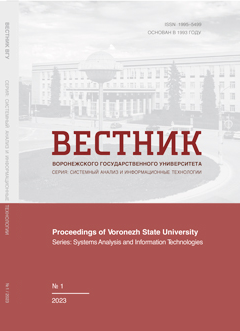Automation algorithm of the information search and fixation in unformalized messages for the management of socially significant intelligent projects
Аннотация
The article discusses the importance of automation for managing the intelligent processes and evaluating the effectiveness of processes. Often this process requires the creative approach of an analyst who has to read a lot of media information relating to the crowdsourcing project activity. This may be messages from users, persons concerned, experts` comments and other information generated by society as a response to the project activity. For many reasons, this is a non-optimal process, firstly, an analyst must review the entire array of information to estimate the project activity, and it is difficult to parallel this task. Since the social situation is subject to variation just for several hours and the human factor keeps away from such efficiency, then the evaluation relevance and up-to-dateness are compromised. It is necessary to automate the evaluation process of the crowdsourcing activity and this is the essence of our approach. We have developed the hierarchic thesaurus for highlighting the information from users` and persons` concerned messages, in the press reports and blog comments. Findings show that crowdfunding projects are hybrid in nature and include the elements of crowdsourcing, crowdsensing, crowdfunding, crowdworking, and crowdsourced recruitment. We explored the possibility of automating the efficiency evaluation of various crowdsourcing working processes and proposed design solutions for the development of such systems. Thе preliminary results indicate that leading issues include the lack of financial guarantees and the likelihood of information leakage to competitors. Hence, the first priority is to manage the exchange of money and information. By following this strategy, the crowdsourcing platforms will reach a high level of responsibility among project initiators and participants and will reduce the likelihood of tax avoidance by individuals, who received a financial reward.
Скачивания
Литература
2. Schenk E. and Guittard C. (2009) Crowd-sourcing: What can be Outsourced to the Crowd, and Why. Workshop on open source innovation, Strasbourg, France. 72.
3. Crouch C. J. (1990) An approach to the automatic construction of global thesauri. Information Processing & Management. 26(5). P. 629–640.
4. Fuger S., Schimpf R., Füller J. and Hutter K. (2017) User roles and team structures in a crowd-sourcing community for international development – a social network perspective. Information Technology for Development. 23(3). P. 438–462.
5. Sambrekar K. and Rajpurohit V. S. (2019) Fast and Efficient Multiview Access Control Mechanism for Cloud Based Agriculture Storage Management System. International Journal of Cloud Applications and Computing (IJCAC). 9(1). P. 33–49.
6. Wolfson S. M. and Lease M. (2011) Look before you leap: Legal pitfalls of crowdsourcing. Proceedings of the American Society for Information Science and Technology. 48(1). P. 1–10.
7. CF The Crowdfunding Industry Report (2015) URL
8. Searles R., Herbein S., Johnston T., Taufer M. and Chandrasekaran S. (2019) Creating a portable, high-level graph analytics paradigm for compute and data-intensive applications. International Journal of High Performance Computing and Networking. 13(1). P. 105–118.
9. Global Crowdfunding Market 2016–2020, 2019. URL
10. Global Crowdfunding Market 2017–2021, 2019. URL
11. Azad H. K. and Deepak A. (2019) Query expansion techniques for information retrieval: a survey. Information Processing & Management. 56(5). P. 1698–1735.
12. Efthimiadis E. N. (1996) Query Expansion. Annual review of information science and technology (ARIST). 31. P. 121–87.
13. Schuster R., Schuster T., Meri Y. and Shmatikov V. (2020) Humpty Dumpty: Controlling word meanings via corpus poisoning. 2020 IEEE Symposium on Security and Privacy (SP). IEEE.
14. Campos R., Mangaravite V., Pasquali A., Jorge A., Nunes C. and Jatowt A. (2020) YAKE! Keyword extraction from single documents using multiple local features. Information Sciences. 509. P. 257–289.
15. Howe J. (2006) The rise of crowdsourcing. Wired magazine. 14(6). P. 1–4.
16. Hosseini M., Phalp K., Taylor J. and Ali R. (2015) On the Configuration of Crowdsourcing Projects. International Journal of Information System Modeling and Design. 6(3). P. 27–45.
17. Wazny K. (2017) “Crowdsourcing” ten years in: A review. Journal of global health. 7(2).
18. Simperl E. (2015) How to use crowdsourcing effectively: Guidelines and examples. Liber Quarterly. 25(1). P. 18–39.
19. Lenart-Gansiniec R. (2018) Methodological challenges of research on crowdsourcing. Journal of Entrepreneurship, Management and Innovation. 14(4). P. 107–126.
20. Zhao Z. (2019) Idea Crowdsourcing for Innovation: Fundamentals and Recommendations. Management & Data Science. 3(2).
21. Wilson K. B., Bhakoo V. and Samson D. (2018) Crowdsourcing: A contemporary form of project management with linkages to open innovation and novel operations. International Journal of Operations & Production Management. 38(6). P. 1467–1494.
22. Taeihagh A. (2017) Crowdsourcing, sharing economies and development. Journal of Developing Societies. 33(2). P. 191–222.
23. McKinley D. (2012) Practical management strategies for crowdsourcing in libraries, archives and museums. URL
24. Niu X. J., Qin S. F., Vines J., Wong R. and Lu H. (2019) Key crowdsourcing technologies for product design and development. International Journal of Automation and Computing. 16(1).
P. 1–15.
25. Harrison S. E. and Johnson P. A. (2016) Crowdsourcing the disaster management cycle. International Journal of Information Systems for Crisis Response and Management (IJISCRAM). 8(4). P. 17–40.
26. Saldanha F. P., Cohendet P. and Pozzebon M. (2014) Challenging the stage-gate model in crowdsourcing: The case of Fiat Mio in Brazil. Technology Innovation Management Review. 4(9). P. 28–35.
27. de Beer J., McCarthy I. P., Soliman A. and Treen E. (2017) Click here to agree: Managing intellectual property when crowdsourcing solutions. Business Horizons. 60(2). P. 207–217.
28. Iren D. and Bilgen S. (2014) Cost of quality in crowdsourcing. Human Computation. 1(2). P. 283–314.
29. Naroditskiy V., Rahwan I., Cebrian M. and Jennings N. R. (2012) Verification in referral-based crowdsourcing. PloS one. 7(10). e45924.
30. Santos C. P., Khan V. J. and Markopoulos P. (2014) On utilizing player models to predict behavior in crowdsourcing tasks. International Conference on Social Informatics. Springer, Cham. P. 448–451.
31. Grossman D. A. and Frieder O. (2012) Information retrieval: Algorithms and heuristics. Springer Science & Business Media. 15.
32. Curran J. R. (2004) From distributional to semantic similarity.
33. Saidi F., Trabelsi Z., Salah K. and Ghezala H. B. (2017) Approaches to analyze cyber terrorist communities: Survey and challenges. Computers & Security. 66. P. 66–80.
34. Baeva O. N. and Malyshenko G. V. (2017) On issue of essence and scales of using crowdsourcing. Baikal Research Journal. 8(2).
35. Kim M., Gupta B. B. and Rho S. (2018) Crowdsourcing based scientific issue tracking with topic analysis. Applied Soft Computing. 66. P. 506–511.
36. Gou Z., Yamaguchi S. and Gupta B. B. (2017) Analysis of various security issues and challenges in cloud computing environment: a survey. Identity Theft: Breakthroughs in Research
and Practice. IGI Global. P. 221–247.
37. Von Hippel E. (2009) Democratizing innovation: the evolving phenomenon of user innovation. International Journal of Innovation Science. 1(1). P. 29–40.
38. Gupta B. B. (Ed.) (2018) Computer and cyber security: principles, algorithm, applications, and perspectives. CRC Press.
39. Jiang F., Fu Y., Gupta B. B., Lou F., Rho S., Meng F. and Tian Z. (2018) Deep learning based multi-channel intelligent attack detection for data security. IEEE transactions on Sustainable Computing.
40. Ramos J., Nedjah N., de Macedo Mourelle L. and Gupta B. B. (2018) Visual data mining for crowd anomaly detection using artificial bacteria colony. Multimedia Tools and Applications.
77(14). P. 17755–17777.
- Авторы сохраняют за собой авторские права и предоставляют журналу право первой публикации работы, которая по истечении 6 месяцев после публикации автоматически лицензируется на условиях Creative Commons Attribution License , которая позволяет другим распространять данную работу с обязательным сохранением ссылок на авторов оригинальной работы и оригинальную публикацию в этом журнале.
- Авторы имеют право размещать их работу в сети Интернет (например в институтском хранилище или персональном сайте) до и во время процесса рассмотрения ее данным журналом, так как это может привести к продуктивному обсуждению и большему количеству ссылок на данную работу (См. The Effect of Open Access).



















